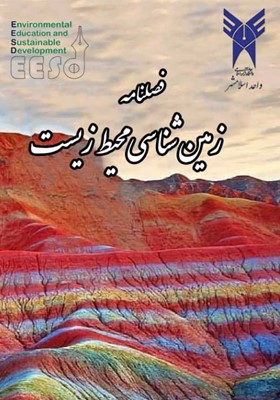ارزیابی عددی و آماری پدیده مچالهشوندگی در تونل غرب کرمانشاه
محورهای موضوعی : فصلنامه زمین شناسی محیط زیستواحد قیاسی 1 * , علی گداری همت 2
1 - گروه مهندسی عمران دانشکده مهندسی عمران و معماری، دانشگاه ملایر
2 - گروه مهندسی عمران دانشکده مهندسی عمران و معماری دانشگاه ملایر
کلید واژه: FLAC2D, خزش, پدیده مچالهشوندگی, تونل انتقال آب WKTC, روشهای تجربی و تحلیلی, روش آماری,
چکیده مقاله :
در این پژوهش به پدیده مچالهشوندگی توسط روشهای تجربی، نیمهتجربی و تحلیلیـتئوریک پرداخته شده، سپس مقطع بحرانی از نظر بیشترین پتانسیل مچالهشوندگی تعیین شده و در نهایت مدلسازی عددی و بررسی آماری این پدیده انجام شده است. در این تحقیق براساس نتایج حاصل از روشهای تجربی و تحلیلی تودههای سنگی مقاطع گورپی(Gu) و خرد شده (Cz) به عنوان مقاطع مچالهشونده شناسایی شدند. سپس مدلسازی این مقاطع توسط نرمافزار عددی تفاضل محدود پیوستهFLAC2D با مدل برگر به مدت 30روز (درازمدت) انجام شد. نتایج این مدلسازی جابجاییهای بسیار بزرگی را نشان داد که ناشی از کیفیت بسیار پایین توده سنگ و روباره زیاد در این پهنهها از تونل است. نتایج مدلسازی عددی کوتاه مدت، نشان داد که سپر TBM در این مقاطع گیر نخواهد کرد. همچنین مدلسازی این مقطع در درازمدت، پایداری سگمنتی را نشان میدهد ولی تأثیر این پدیده در دو مقطع مشکلی ایجاد نخواهد کرد. بررسی روش دیفرانسیل محدود پدیده مچالهشوندگی و آماری این تونل از نوآوریهای مهم این پژوهش میباشد. پدیده مچالهشوندگی تونل میتواند پایداری و بهرهبرداری آن را به خطر بیاندارد. پیشبینی میزان جابجایی، کرنش شعاعی، کرنش برشی و گسترش ناحیه پلاستیک به عنوان تابعی از درجه مچالهشوندگی و عوامل تشدیدکننده آن یکی از نیازهای اساسی حفر و نگهداری تونل است. مچالهشوندگی رفتاری در رابطه با تغییر شکل توده سنگ ضعیف و ویژگیهای مقاومتی آن میباشد. این پدیده با تغییر شکلهای بزرگ و همگراییهای وابسته به زمان در طی حفاری تونل همراه است. در اثر ایجاد و ترکیب تنشهای القایی، تنش موجود از حد مقاومت برشی گذشته و توده سنگ به داخل محدوده حفرشده رانده میشود. این تغییر شکلها ممکن است در طی حفر تونل یا در دوره زمانی طولانی مدت ادامه داشته باشد. تونل انتقال آب با طولی حدود 8550 متر و قطر884/6 متر در غرب ایران و استان کرمانشاه واقع است. بخش اعظمی از مسیر تونل از سنگهای آهکی به همراه شیل و مارن تشکیل شده و در آن چندین زون گسل به همراه ساختار تاقدیسی به چشم میخورد و حداکثر روباره در مسیر تونل 570 متر میرسد. این موضوع شرایط را برای وقوع پدیده مچالهشوندگی مهیا میکند. به همین منظور به ارزیابی، مدلسازی و تحلیل این پدیده در تونل پرداخته شد.
In this paper, based on the results of experimental and analytical methods, crushed zone and gurpy rocks masses were identified as the squeezing sections. Then crushed zone and gurpy sections creep parameters at the Bruger model were obtained in the laboratory. Then crushed zone and gurpy sections modelling using the software Flac2D with burgers model for 30 days (long-term) were performed. Our numerical modelling results show the large displacements due to very low quality of the rock mass and high overburden in this sections of the tunnel. The results of the numerical modelling in the short-term, that TBM shield would be stuck in this section of tunnel. Also modeling this section in the long-term showed that stability and not seen failure of the segmental support system. But effect squeezing in two sections is not critical. Among the important phenomena that makes problem for tunneling, support and tunnel usage is squeezing which is a type of problems that takes place in weak rocks. Squeezing of the rock is time dependent large convergence, which occurs around the tunnel, and is essentially associated with creep caused by exceeding limiting shear strength. Squeezing is one of the important phenomena in the tunneling industry so drilling in the squeezing cases can be causing serious problems. Predicting the amount of displacement, radial strain, shear strain and plastic zone increment as functions of the squeezing degree resonator factors is one of the basic needs in drilling and tunnel maintenance. Squeezing is behavior that related with weak rock mass deformation and strength properties. This phenomenon is associated with large deformations and time dependent convergence during tunnel excavation. It takes place when a particular combination of induced stresses and material properties pushes some zones around the tunnel beyond the limiting shear stress at which creep starts. Deformation may terminate during construction or continue over a long period of time. West Kermanshah tunnel conveyance (WKTC), with about 8550 meters long and 6.884 m in diameter in the west of Iran is located in Kermanshah province. Mainly parts of the tunnel pass through weak rock make is including types of argillaceous, sandstone and shale, with high 570 meters overburden and will be probably under squeezing condition. Duets in this project the effect of experimental methods, analytical and semi-analytical are evaluated. Then critical section of the squeezing potential presented and finally numerical modelling of this phenomenon is done.
_||_

